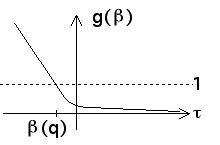| To see that for each q the equation (p1q)(r1tau(q)) + ...
+ (pNq)(rNtau(q)) = 1 determines a unique value of tau(q),
for each q define a function g(tau) by |
| g(tau) = (p1q)(r1tau) + ...
+ (pNq)(rNtau) |
| Certainly, g(tau) is a continuous function. |
| Recall that 0 < ri < 1 and 0 < pi < 1 for all i. |
As tau -> infinity, each ritau -> 0, and so g(tau) -> 0. |
As tau -> -infinity, each ritau -> infinity, and so g(tau) -> infinity. |
Finally, dg/dtau = (p1q)(r1tauln(r1)) + ...
+ (pNq)(rNtauln(rN)) < 0 |
|
| Combining these three observations, we see the graph of g(tau) must look something like this |
 |
| That is, g(tau) decreases from large positive values to nearly 0, so g(tau) = 1 for exactly one value of tau,
and this is tau(q) for the given value of q. |
| |
| If all the ri take on a common value, r, the equation |
| (p1q)(r1tau(q)) + ...
+ (pNq)(rNtau(q)) = 1 |
| can be solved for tau(q): |
| tau(q) = -ln(p1q + ... + pNq)/ln(r). |

